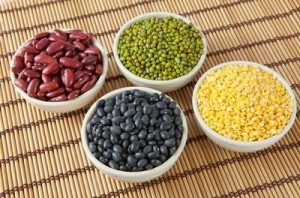Are you curious about plant based eating but are worried you won’t be able to get enough protein or maintain your muscle mass?
Nearly 99% of the time when a person learns that I eat mostly a plant based diet, their first question is “But where do you get your protein?” There are many plant sources for protein, but first let me break down how I have figured out how much protein an average person like me really needs.

WebMD.com recommends a minimum of 10% of daily calories from dietary protein with a maximum set at 35%. A researched article on Livestrong.com suggests athletes should consume between 10-15% of their daily calories from protein. Dr. Douglas Graham, athletic trainer and author of The 80/10/10 Diet, recommends a maximum of 10% of daily calories from protein.
So who is right and which advice should be followed? Let’s first realize that chances are slim that we’ve ever met anyone with a protein deficiency. In fact, there is no medical term in America for such a condition. A person would have to eat a diet strictly of oil (isolated fat) and table sugar (isolated carbohydrate) over a significant period of time to develop a true protein deficiency. So it’s safe to say that without paying close attention to it, most Americans like you and me are eating enough protein whether it be high quality, low quality, animal or plant-based protein.
Animal protein is found in meat (not just red beef meat, but any animal flesh), dairy and eggs. Plant protein can be found in grains, legumes (beans, peas, lentils), nuts, seeds, fruit & vegetables. Across the globe plant protein accounts for 60% of dietary protein while in America animal protein accounts for a whopping 70% of protein sources.
Protein is a nutrient which is required by humans for growth and maintenance, but not for fuel. The basic units of protein, called amino acids, are used for building and repairing new tissue and muscle. All consumed animal and plant protein must be broken down into the basic single amino acid building blocks during digestion before being available for utilization in the body. The body “pools” the assorted single amino acids and re-assembles them as needed for protein demands of the body.
While protein deficiency is rare, interestingly there is ample evidence in America of animal protein over-consumption. The formation of kidney stones, gout, Type 2 diabetes, cardiovascular disease and metabolic syndrome are all related to urate crystals forming when uric acid is not metabolized during purine (animal protein) digestion. Animal proteins are very acidic in nature and lead to inflammation in the internal body environment.
Calcium urate crystals can form when the body pulls calcium from bones & teeth to neutralize the acidity of animal protein digestion which then can give rise to arthritis, rheumatism, bursitis, high blood pressure, osteoporosis, and varicose veins.
In order to avoid these common maladies, it would be wise to be mindful of how much animal protein is being consumed. If protein measures 4 calories per gram whether from animal or plant, a person consuming 1,700 calories a day (adequate for a moderately active female adult like me) could consume 42.5 grams of protein per day if aiming for 10% of daily calories from protein.
One Arby’s Roast Turkey & Swiss Wrap has 34 grams of protein. Eight to nine more grams of daily protein could be easily obtained from an assortment of fruit, veggies, nuts, seeds and legumes. Anyone wishing to avoid animal derived protein can smartly consume enough high protein plant foods to meet daily requirements. A useful chart like this one helps break down the protein, fat and carbohydrates in plant foods. For example 1 cup of green peas has 14.5 grams of carbohydrates, 5.4 grams of protein and 0.4 grams of fat.
If any of the typical protein over-consumption ailments develop in your body, scale back on the animal protein and increase your intake of plant protein. There are no studies that show disease developing from an over-consumption of plant based protein which are mostly alkaline in nature. The trick here is to stack up your plate with quality plant protein while keeping fat content in check as the two are usually packaged together (think avocado, olives, seeds, nuts, coconut).
Raw protein is generally a cleaner and more bioavailable form of dietary protein because the molecular structure has not been altered by heat. Raw animal protein can be explored through sushi (raw fish), raw milk and raw eggs. Do your research and be careful to source your raw foods from high-quality providers to avoid toxic microorganisms. Raw plant protein can easily be found in greens, nuts, fruit and seeds. The key to protein consumption is to eat a variety of protein sources in order to “pool” an assortment of all the necessary essential and nonessential amino acids. You can read in detail more about essential (can not be created by the body) and nonessential amino acids (can be created by the body) here.
I personally enjoy eating Dr. Graham’s 80/10/10 way approximately 80% of the time. Over the years I have detached from labels (vegan, raw vegan, pescetarian, etc.) which I find too restrictive and have developed a way of eating that pleases me and keeps me well nourished. I eat a lot of raw fruit and salads during the week and between Friday night and Saturday night you might catch me at the sushi bar or enjoying a cooked veggie, bean and rice burrito with ample guacamole. This format helps my food weekends feel different and special from my food week and I can easily be social with friends at restaurants during this “20%” time. (UPDATE: as of January 1, 2015 I am 100% vegan.)
Arriving at this unique way of eating has been the result of studying food casually and formally, listening to my body and leading my life from my heart. I enjoy the clean fuel & nutrition that raw plants provide and I supplement my mostly vegan diet with fish & eggs rather than omega-3 and B12 capsules. My diet allows me to stay active (walk, swim and jog occasionally), work hard, sleep well, feel happy, maintain a slim body size (5’7”, size 6) and feel great in my skin. I have noticed that since I started eating this way that my oxygen utilization is more efficient so I feel in better cardiovascular shape with less training. Also by focusing more on my quality of food, my fitness and body size are easier to maintain. I eat a lot of plants, never feel hungry and effortlessly keep my body fat in check. My online food diary is here if you’d like to take a peek.
You can, with understanding and knowledge, get enough protein to support your fitness goals and avoid common excessive animal protein ailments by intaking more plant proteins. You might be surprised how little you need and how great you feel shifting to more alkaline and oxygen-rich plant based protein options.

{ 2 comments… read them below or add one }
Exercise is one of those rare things where the hype actually meets reality. Next to not smoking, getting regular physical activity is arguably the best thing you can do for your health. Any amount of exercise is better than none. The more you get, though, the better. And remember: Cutting back on television-watching and other sedentary pastimes is just as important as becoming more active.
You’re right, exercise and not-smoking are VERY important. Diet is also extremely important as well as quality sleep and good social and family relationships. That said, one can not out-exercise a poor diet.